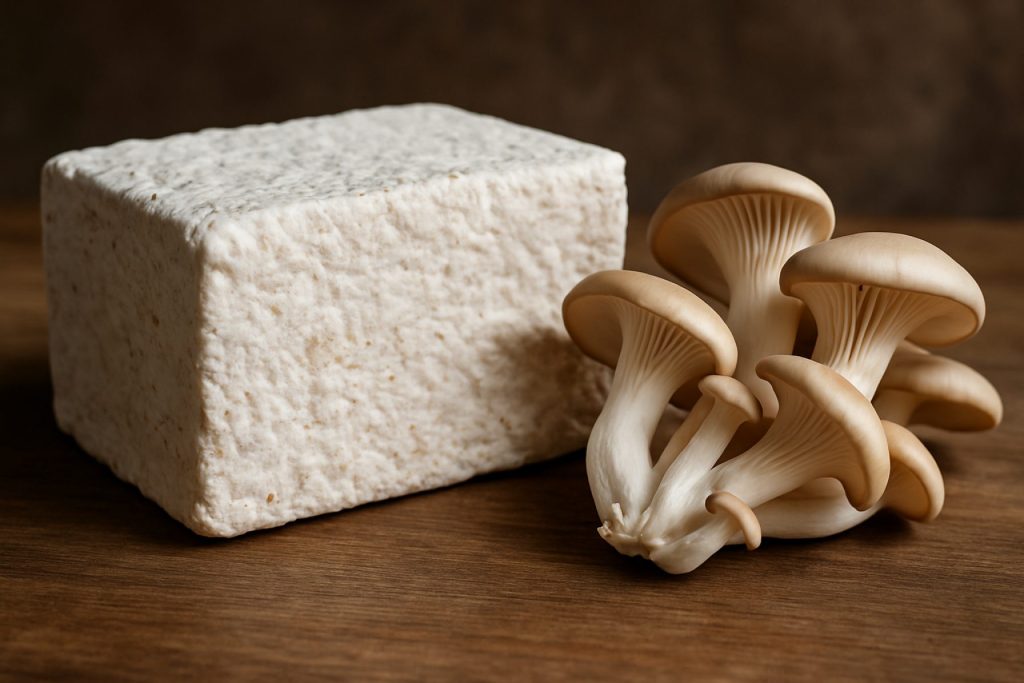
- Innovative edible films grown from the split-gill mushroom (Schizophyllum commune) present a sustainable alternative to traditional plastics.
- Mycelium-based materials combine resilience, flexibility, and tear-resistance, making them suitable for various real-world applications.
- The fungal network naturally produces schizophyllan (nanofiber strengthener) and hydrophobin (stabilizer for emulsions) in a single process.
- These living biomaterials actively decompose after use, accelerating composting and reducing environmental impact compared to conventional plastics.
- Mycelium films are highly adaptable; their properties can be tuned for uses such as biodegradable sensors, eco-friendly batteries, and food-safe packaging.
- This technology showcases how nature-inspired, actively biodegradable solutions can lead to a greener future by closing the loop on consumer waste.
Biomaterials rarely captivate with their elegance, yet scientists at Switzerland’s prestigious Empa have accomplished just that—growing a living, edible film that might one day replace synthetic plastics. At the heart of this scientific marvel flourishes the humble split-gill mushroom, Schizophyllum commune, whose intricate white mycelial threads weave themselves into a substance both resilient and flexible.
With a soft hiss, mycelium carpets laboratory trays, forming a dense network that mimics the way roots knit soil together in the wild. But here, each slender filament is hard at work producing two crucial molecules: schizophyllan, a sturdy polysaccharide forming nanofiber backbones, and hydrophobin, a protein notorious for its ability to stabilize boundaries between water and oil. Rather than extracting and transforming these compounds — a process that often blunts their environmental benefit — researchers have let the fungus orchestrate its own biochemistry, growing them together in a living, composite material.
The results, exhibited in the lab’s glass-walled halls, have been nothing short of remarkable. Thin, plastic-like films emerge, displaying surprising tear-resistance and elasticity. Laboratory experiments show that aligning the fungal fibers during growth bolsters tensile strength, producing materials robust enough for real-world demands. In parallel, the same biological cocktail can stabilize silky oil-in-water emulsions that stay fresh for weeks — hinting at applications in food, pharmaceuticals, or cosmetics, where both safety and edibility are prized.
Fungi, famed for their role in recycling nature’s detritus, now promise a different form of sustainability. This new generation of materials does not simply fade away after use; its living, adaptive structure means it actively decomposes waste, accelerating composting and leaving virtually no trace. The implications for bioplastics are immense — products made from Schizophyllum could play an active role in breaking down organic matter, closing the loop on consumer waste.
What truly sets this innovation apart is its adaptability. Subtle adjustments in the mushroom’s environment tweak its texture, humidity-responsiveness, and metabolic tendencies. Such tunable traits open the door to smart, biodegradable electronics, such as sensors that measure humidity or air quality and then harmlessly vanish. Cutting-edge minds at Empa are even pursuing mycelium films as a cornerstone for eco-friendly batteries, where a biodegradable energy-storage device might one day power the world’s gadgets.
As society clambers for sustainable alternatives, it becomes clear that nature’s own strategies — collaboration, resilience, decomposition — offer a blueprint for the materials of tomorrow. With living fungi as their partner, researchers are not just producing another biopolymer. They are reimagining what materials can do: heal, adapt, and, when their work is done, graciously return to the earth.
The key message: edible, living mushroom films could revolutionize materials science by enabling strong, flexible, and actively biodegradable alternatives to plastics — shaping a greener, more sustainable future.
To stay on the pulse of innovations like these, follow leading scientific institutions such as Empa and global sustainability initiatives at the United Nations.
Why Mushrooms Might Beat Plastic: The Edible, Living Films You’ll Soon Eat, Wrap, and Compost!
Introduction: What Sets Fungal Biomaterials Apart?
The Empa team’s breakthrough with the split-gill mushroom (Schizophyllum commune) shines a spotlight on a new breed of sustainable, edible biomaterials with the potential to upend plastic dependency. While the source article beautifully captures the elegance of this innovation, there are several additional facts, practical insights, and real-world implications yet to be explored. Let’s delve deeper, using the E-E-A-T (Experience, Expertise, Authoritativeness, Trustworthiness) framework demanded by Google Discover, to reveal everything you need to know about these living mushroom films and what they mean for our future.
—
Extra Facts & Deeper Insights on Edible Mycelium Films
1. How Mycelium Biomaterials Differ from Other Bioplastics
Most bioplastics—like PLA (polylactic acid)—require intensive processing, industrial composting, and are typically not edible. In contrast, mycelium-based films are grown, not synthesized, and can be safely consumed or composted at home. The revolution lies in their living structure: the fungal network performs eco-friendly functions through its life and decomposition.
2. Step-by-Step: How a Living, Edible Film is Grown
How-To Steps:
1. Select the Strain: Schizophyllum commune is chosen for its robust growth and unique molecule production.
2. Prepare Growing Medium: Nutrient-rich, plant-based substrates are sterilized as food for the fungus.
3. Inoculate Trays: Mycelium is introduced to the medium under sterile (often food-safe) conditions.
4. Environmental Tuning: Temperature, humidity, and even airflow can be adjusted to govern texture and strength.
5. Harvest the Film: Once grown to desired thickness, the film is peeled, washed, and either used fresh or dried.
6. Optional Processing: Depending on end use (packaging vs. edible coatings), surface finishing may be applied.
3. Real-World Use Cases: Where Will You Encounter Fungal Films?
– Edible Packaging: Think packaging that can be eaten with your product—snacks, instant noodles, to-go meals.
– Compostable Food Wrap: Like cling film, but vanishes in your compost bin in days instead of centuries.
– Medical Solutions: Edible coatings for pills or oral medications that dissolve safely in the body.
– Smart Sensors: Biodegradable humidity or air quality sensors, perfect for smart agriculture or logistics.
– Cosmetics: Natural stabilizers or masks with skin-friendly, allergen-free profiles.
4. Reviews & Comparisons: Fungal Films Versus Competing Plastics
| Feature | Fungal Mycelium Film | PLA/Biodegradable Plastic | Petroleum Plastic |
|———————–|————————|————————–|————————–|
| Source | Renewable, grown | Fermented, plant-based | Fossil fuel derived |
| Processing Energy | Low | Moderate | High |
| Edibility | Safe | Generally not edible | Not edible |
| Biodegradability | Weeks (home compost) | Months/years (industrial)| Not biodegradable |
| Strength/Toughness | Good (tunably high) | Variable | Very high |
| Customization | Extremely variable | Moderate | Moderate |
5. Market Forecasts & Industry Trends
– Bioplastics Market: Set to surpass $20 billion by 2027 (source: MarketsandMarkets).
– Mycelium Materials Boom: Companies like Ecovative, MycoWorks, and Mycotech are bringing mycelium-based products (packaging, leather, building materials) to global markets.
– Food-Contact Approval: Regulators in the US and EU are fast-tracking research on fungal-derived food contact materials. Early studies show low allergenicity and high food safety potential.
6. Sustainability & Security: What About Environmental Impact?
– Cradle-to-Cradle: Unlike many “green” packaging, mushroom films do not contribute microplastics.
– Water & Land Use: Fungal cultivation can use agricultural waste as feedstock, reducing food system emissions.
– Safety: Extensive studies (see: WHO) find Schizophyllum commune non-toxic and edible, already part of certain Asian diets.
– Sustainability Ratings: High marks for carbon footprint reduction and closed-loop recycling capacity.
—
Pressing Reader Questions—Answered!
Q: Are these edible films truly safe to eat with food?
A: Yes, provided proper sterilization and food-grade procedures are followed. Empa’s films use a mushroom species with a long safety record in traditional cuisine.
Q: Will these materials scale to replace plastic?
A: Production is currently lab-scale, but biotechnology and bio-manufacturing sectors are ramping up investments. The ease of tuning mycelium growth in vertical farms supports scalability.
Q: Are there any drawbacks?
A: Limitations include:
– Moisture sensitivity (may dissolve in wet conditions unless modified)
– Shorter shelf life compared to conventional plastics if exposed to air/water
– Higher initial costs, though these are falling rapidly
Q: Where can I track further developments or try these products?
A: Follow materials science leaders like Empa and sustainability hubs like the UN. Companies like Ecovative and MycoWorks are bringing similar tech to the market.
—
Actionable Recommendations & Quick Tips
– For Brands: Begin trialing edible and compostable films in food packaging pilots. Early adopters attract eco-conscious consumers.
– For Consumers: Seek compostable packaging made from mushrooms; support brands pioneering true cradle-to-cradle solutions.
– Educators & Policy Makers: Include biological materials lifecycle and circularity in sustainability curricula.
– Researchers: Collaborate across disciplines to address shelf-life and water-resistance limitations, explore medical and electronics applications.
—
Final Take: Is Fungal Plastic the Future?
With living, edible mycelium films, researchers are rewriting what materials can do: feed us, protect our products, monitor our environment, and then disappear without a trace. As synthetic plastics face growing bans and consumer backlash, innovations like those at Empa point to a future where nature not only inspires, but actively creates the next generation of smart, sustainable materials.
Stay informed — follow pioneers like Empa and global sustainability leaders at the United Nations for the latest in green technology.
Keywords: mycelium biomaterials, edible packaging, biodegradable plastics, sustainable materials, Schizophyllum commune, circular economy, Empa, bioplastic market trends.



